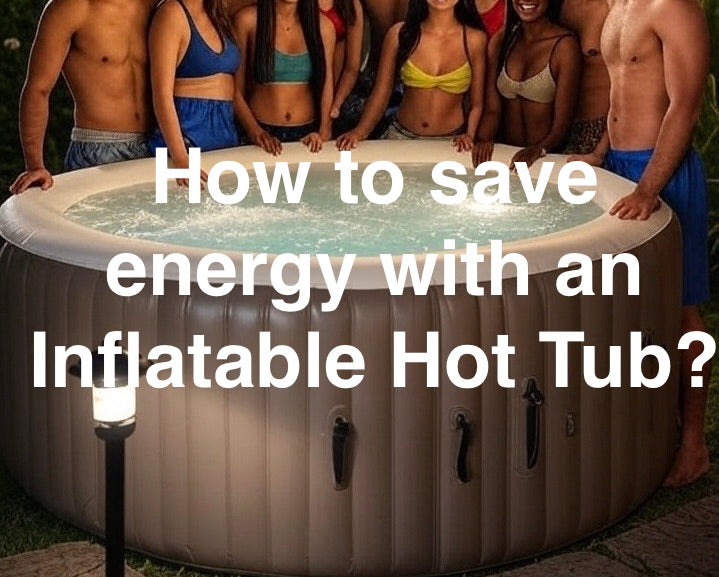
How to Save Energy with an Inflatable Hot Tub
Picture this: you’ve just tucked the kids into bed, grabbed a glass of wine, and slipped into your bubbly inflatable spa… bliss. Until you remember the energy bill. The short answer? Inflatable hot tubs do use a fair bit of power—but with a few clever tricks, you can slash those costs without sacrificing comfort. Keep reading for easy, practical ways to save energy and money.

The Core Principle: Insulation and Heat Retention
When it comes to inflatable hot tubs, heat loss is your biggest enemy. The water’s lovely and warm, but without proper insulation, that heat escapes faster than your patience on a rainy school run.
Upgrade Your Cover and Lid
How a Good Cover Prevents Heat Loss
A well-fitted cover works like a blanket on a chilly night. It traps the warmth inside and keeps cold air out. Without one, you’re basically paying to heat the garden.
The Role of a Thermal Blanket or Ground Mat
Think of a thermal blanket as a cosy duvet for your hot tub. Placed directly on the water’s surface, it keeps the heat locked in. Pair it with a ground mat underneath to stop warmth leaking into the soil.
The Benefits of an Inflatable Hot Tub Cover Cap
These clever caps act as an extra protective layer on top of your main lid. They reduce heat loss and add another barrier against the cold—especially handy in winter.
Optimising Your Hot Tub's Environment
It’s not just what’s on your hot tub that matters, but also what’s around it. A bit of smart positioning can save you pounds in the long run.
Create a Windbreak
Using Landscaping (e.g., Plants, Fences) to Protect Your Hot Tub
Strong winds whip away heat faster than you can say “bubbles.” Positioning your tub behind a fence, hedge, or even a few potted plants can make a surprising difference.
The Impact of Wind on Heat Loss
Even a light breeze cools the water’s surface. Protecting your tub from draughts means your heater won’t need to work overtime.
Insulate the Ground and Sides
The Importance of a Thermal Mat or Insulated Base
Most of the heat escapes through the bottom of the tub. A thermal mat acts as a barrier, keeping the warmth where it belongs—in the water.
The Use of Insulating Wraps or Jackets for the Sides
Insulated jackets aren’t just for people. Wrapping your spa’s sides in a purpose-made thermal cover helps keep that precious warmth from escaping.
Smart Practices for Daily Use and Maintenance
Big savings often come from small daily habits. With a few tweaks to how you use and care for your tub, you can keep costs under control.
Manage Your Temperature Settings
The Benefits of a Lower Temperature Setting
Dropping the water temperature by just a degree or two can save up to 3% on your energy bill. You’ll hardly notice the difference when you’re in the tub, but your wallet will.
Using a Timer or Smart Plug to Heat Water During Off-Peak Hours
Why pay peak rates to heat your tub? A timer or smart plug lets you warm it up when electricity is cheaper, so it’s ready when you are.
The Importance of Turning Down the Temperature When You're Not Using the Hot Tub for an Extended Period (e.g., Holiday)
Heading away for a few days? Don’t waste energy keeping the water toasty. Drop the temperature down, then reheat when you’re back.
Keep It Clean and Efficient
The Link Between Clean Filters and Energy Use
Dirty filters force the pump to work harder, which uses more electricity. Keep them clean and you’ll save energy and extend their life.
The Correct Frequency for Running Your Pump and Filtration Cycles
Running the pump constantly isn’t necessary. Set it to run just long enough to keep the water clean—your energy bill will thank you.
Regular Water Testing and Chemical Maintenance to Avoid Frequent Draining and Refilling
Neglecting water balance means draining and refilling more often. That’s not just water down the drain—it’s heat and energy too. A quick water test kit can save a lot of waste.
The Importance of Location
Choosing a Spot with Natural Protection from Wind and Direct Sunlight
A sheltered spot out of the wind saves energy. Just don’t put it in direct blazing sunlight either, as UV light can damage the spa over time.
Ensuring a Level and Stable Surface
A flat base means even heating and less strain on the pump. If your tub rocks like a boat, it’ll burn more energy trying to keep up.
Conclusion: Relax Smarter, Save More

Inflatable spas are brilliant for family fun or a quiet moment of calm. Yes, they use energy—but with the right habits, smart insulation, and a few inexpensive upgrades, you can keep running costs in check.
The best part? Every pound you save on energy is one you can spend on snacks, toys, or maybe even a bottle of fizz to enjoy in the bubbles.
Have you checked out our other posts?
How Much Electricity Does An Inflatable Hot Tub Use?
Is It Cheaper To Leave An Inflatable Hot Tub On All The Time?
How Much Does An Inflatable Hot Tub Cost To Run In The UK?
How Many Hours A Day Should I Run My Inflatable Hot Tub?
How Heavy Is A Full Inflatable Hot Tub?



Leave a comment